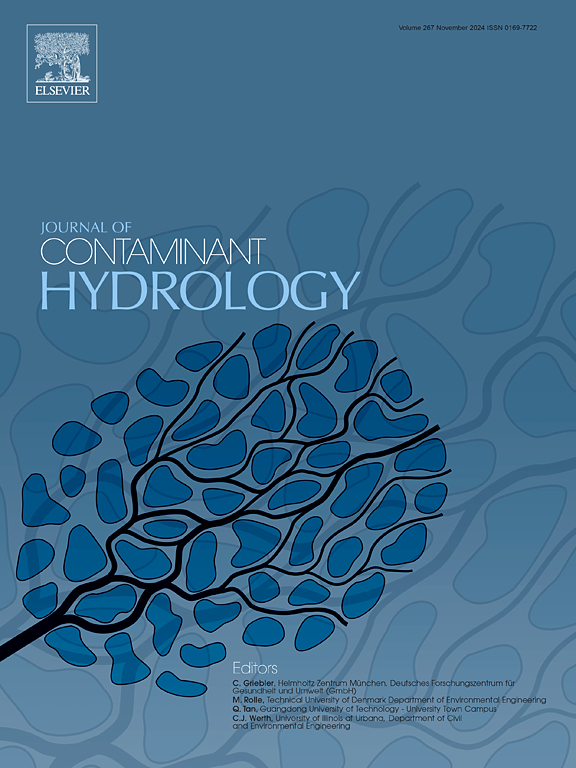Per- and polyfluoroalkyl substances (PFAS) mass flux and mass balance at an aqueous film-forming foam release site in semiarid eastern New Mexico, USA
IF 3.5
3区 环境科学与生态学
Q2 ENVIRONMENTAL SCIENCES
引用次数: 0
Abstract
Passive flux meters (PFMs) directly measure groundwater chemistry mass flux and Darcy flux, providing insight into contaminant source-zone architecture and transport properties. This study uses PFMs to characterize PFAS flux in groundwater at a semiarid site with a thick (greater than 90-m) unsaturated zone where groundwater has been contaminated with per- and polyfluoroalkyl substances (PFAS) related to the use of aqueous film-forming foam (AFFF) for fire training and fire suppression. PFAS mass discharge (PFAS mass flux integrated over a control plane) in groundwater downgradient from several PFAS release areas is calculated using PFM results. In groundwater downgradient from fire-training areas, total PFAS mass discharge (summed across 14 compounds) was estimated to be between 6.0 and 31 g per day in 2020 and between 5.9 and 23 g per day in 2021. Site-specific documentation, generic information on AFFF properties, and literature values of PFAS concentration in AFFF are used to estimate site-specific PFAS-application rates at fire-training areas. These PFAS-application rates are compared to groundwater PFAS-discharge rates. Results suggest that transformation processes (exact pathways unknown) have led to increased discharge of measured PFAS in groundwater relative to initial AFFF formulations. The mass balance approach has broad applicability as a high-level approach that can provide insight into PFAS transport at AFFF sites.

美国新墨西哥州东部半干旱地区一个水成膜泡沫释放点的全氟和多氟烷基物质(PFAS)质量通量和质量平衡
被动通量计(pfm)直接测量地下水化学质量通量和达西通量,提供对污染物源区结构和运输特性的深入了解。本研究使用pfm来表征半干旱地区地下水中的PFAS通量,该地区具有厚(大于90米)的不饱和带,地下水已被与使用水成膜泡沫(AFFF)进行消防训练和灭火有关的全氟烷基和多氟烷基物质(PFAS)污染。利用PFM计算结果计算了不同PFAS释放区地下水下梯度下的PFAS质量流量(控制平面上的PFAS质量通量积分)。在消防训练区的地下水下降梯度中,估计2020年PFAS总排放量(14种化合物的总和)在每天6.0至31克之间,2021年在每天5.9至23克之间。使用特定地点的文件、AFFF属性的一般信息和AFFF中PFAS浓度的文献值来估计火灾训练区域特定地点PFAS的施用量。这些pfas的施用量与地下水pfas的排放量进行了比较。结果表明,相对于初始AFFF配方,转化过程(确切途径未知)导致地下水中测量到的PFAS排放量增加。质量平衡方法作为一种高级方法具有广泛的适用性,可以深入了解AFFF站点的PFAS运输情况。
本文章由计算机程序翻译,如有差异,请以英文原文为准。
求助全文
约1分钟内获得全文
求助全文
来源期刊

Journal of contaminant hydrology
环境科学-地球科学综合
CiteScore
6.80
自引率
2.80%
发文量
129
审稿时长
68 days
期刊介绍:
The Journal of Contaminant Hydrology is an international journal publishing scientific articles pertaining to the contamination of subsurface water resources. Emphasis is placed on investigations of the physical, chemical, and biological processes influencing the behavior and fate of organic and inorganic contaminants in the unsaturated (vadose) and saturated (groundwater) zones, as well as at groundwater-surface water interfaces. The ecological impacts of contaminants transported both from and to aquifers are of interest. Articles on contamination of surface water only, without a link to groundwater, are out of the scope. Broad latitude is allowed in identifying contaminants of interest, and include legacy and emerging pollutants, nutrients, nanoparticles, pathogenic microorganisms (e.g., bacteria, viruses, protozoa), microplastics, and various constituents associated with energy production (e.g., methane, carbon dioxide, hydrogen sulfide).
The journal''s scope embraces a wide range of topics including: experimental investigations of contaminant sorption, diffusion, transformation, volatilization and transport in the surface and subsurface; characterization of soil and aquifer properties only as they influence contaminant behavior; development and testing of mathematical models of contaminant behaviour; innovative techniques for restoration of contaminated sites; development of new tools or techniques for monitoring the extent of soil and groundwater contamination; transformation of contaminants in the hyporheic zone; effects of contaminants traversing the hyporheic zone on surface water and groundwater ecosystems; subsurface carbon sequestration and/or turnover; and migration of fluids associated with energy production into groundwater.
 求助内容:
求助内容: 应助结果提醒方式:
应助结果提醒方式:


